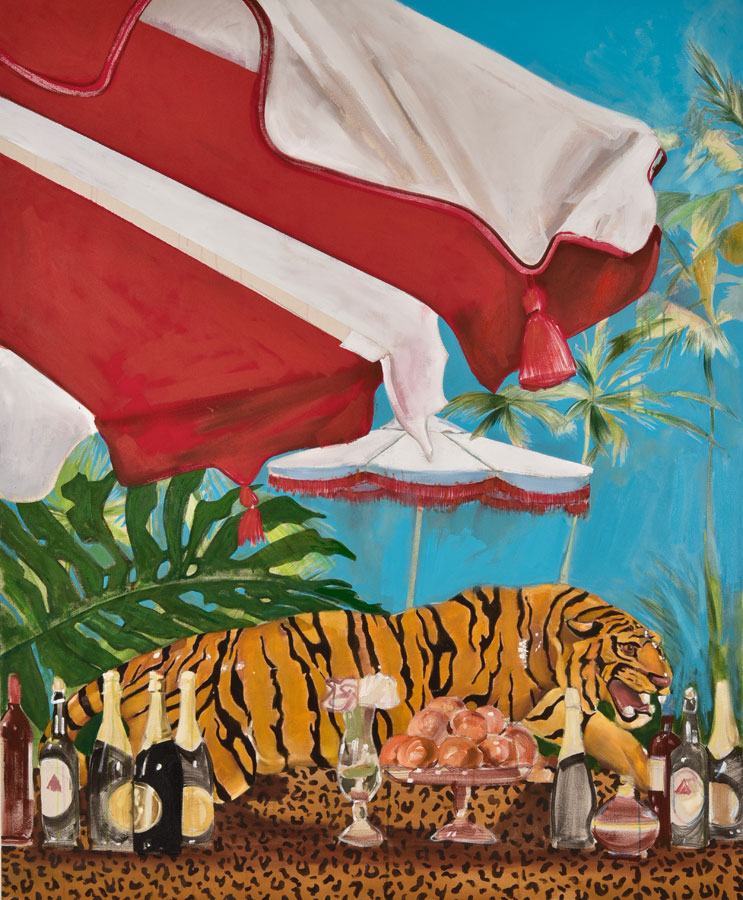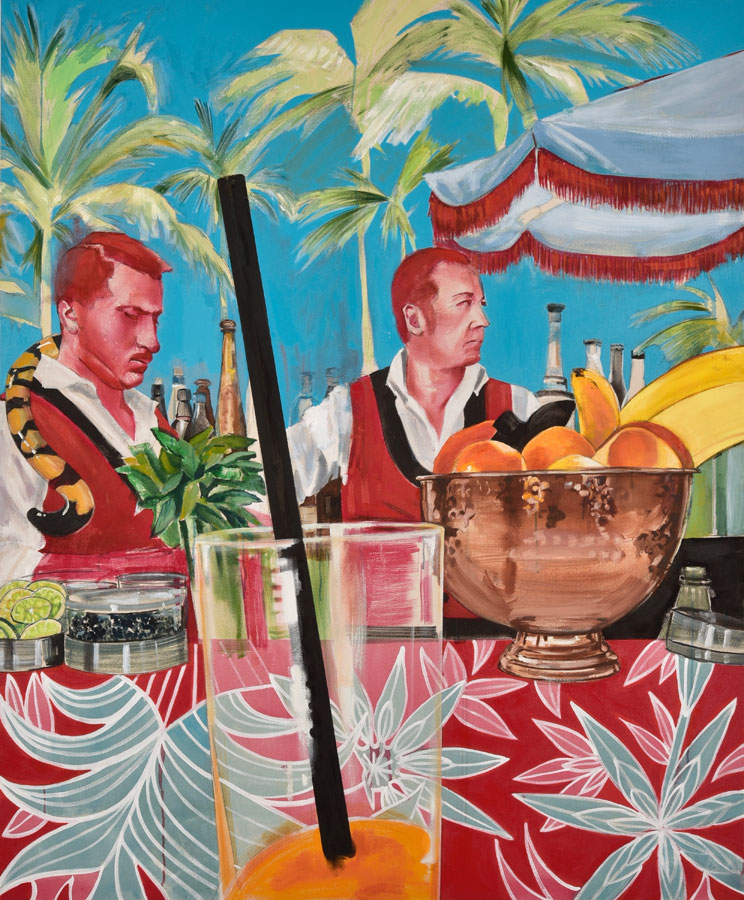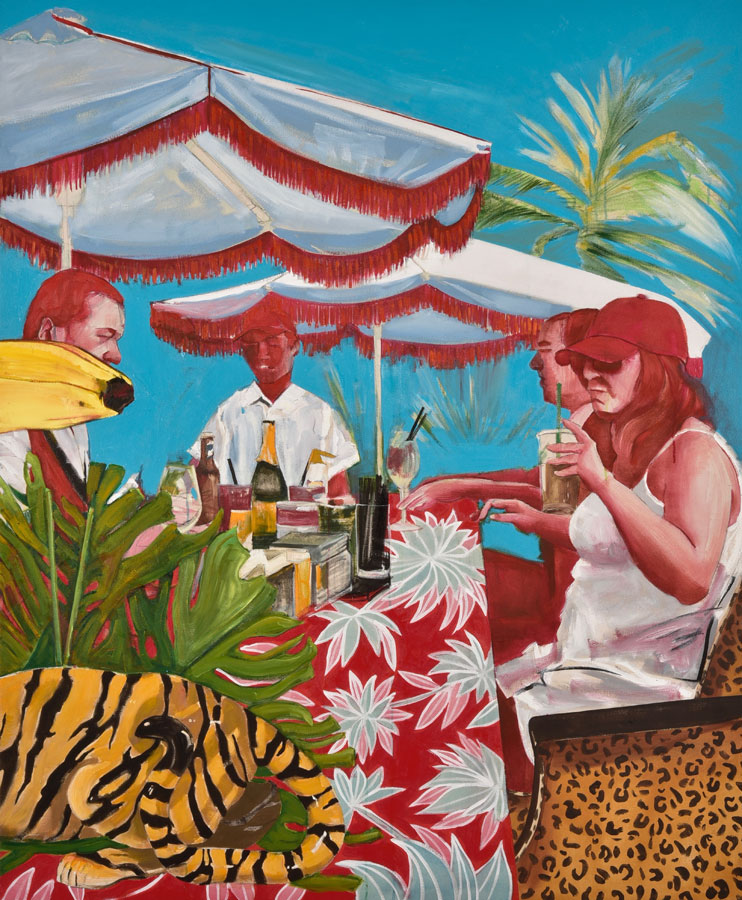Stella Kapezanou through Adorno: Real People in the Palms of their Holiday.
We’re entitled to twenty-eight days of it a year. More, once we’re retired. Who doesn’t want to ‘recharge the batteries’ or get some ‘rest and relaxation’ before the long slog of work begins again? Kapezanou, who won the Clyde and Co., Emerging Star Award in 2017, paints people worshipping the deities of Sun, Sand, and Sea. For they’re the new ‘holy’ trinity of the ‘holiday’.
And yet, we’re aware that our vacationers are in an unreal world. They’ve been transported from the real, physical world of our day-to-day experiences only to appear under the plasticky acrylic of the skies; beside the unrendered canvas; stencilled palm trees; and pop-culture motifs that recur throughout these paintings. Kapezanou’s vacationers are holidaying among images, which, like adverts, signify ‘dream escapes’ and sunny ‘getaways’ among the fronds, parasols, and sea. Ultimately, the scenes are purposefully disjointed. Kapezanou’s style rejects the ‘whole’ of the canvas for a succession of self-contained images and moments that vie with one another for our attention, our distraction. She doesn’t paint harmony. She paints restlessness, boredom.
Pretty In Pink, 2015. Oil and acrylic on canvas. 160×180 cm
Kapezanou’s style is also darkly droll. Consider, for e.g., the vacationer in the top-left of Pretty in Pink (2015) who, in simian curiosity, inspects his beach towel as if it’s from another dimension, which it is given its stark and unrendered appearance. He’s probably just shaking the sand off. Or, simply folding it away. Consider also, the ubiquitous palm trees or comically over-sized vinyl-like bananas that appear below our ape-like hero, which then reappears, (banana-)split, in the centre of the triptych, A Bar at the Faena (2017). Kapezanou’s palm fronds, flower and fruit prints, animal skins, etc., are unashamedly kitsch and reproducible with any glossy printer. Consequently, they’re always shiny and timeless in a tacky sort of way, unable to age.
For all this unreality, we’re still among real, ordinary people. Check out the gloriously loose folds of skin, stretchmarks, and pot-bellies. We’re not among the models that grace the brochures for Sandals and Club Med. We’re among real people, whose marks of mortality offer the only texture and contrast against the catalogue fronds and other pop-culture images. So, what’s in this contrast of the real vs. unreal? We can turn to Theodor W. Adorno, the bespectacled German-Jewish émigré intellectual, for an answer.
Adorno, who couldn’t stand jazz but enjoyed listening to Beethoven when not reading Marx or Hegel, doesn’t immediately come to mind when viewing Kapezanou’s paintings. It’s easy to say that Adorno didn’t really ‘get’ rest and relaxation. Or, did he? His essay, ‘Free Time’ (1969) disparaged ‘those who grill themselves brown in the sun merely for the sake of a sun-tan,’[i] for ‘dozing in the blazing sunshine is not at all enjoyable, might very possibly be physically unpleasant, and certainly impoverishes the mind.’[ii] And yet, we might ask whether any of Kapezanou’s subjects really ‘get’ rest and relaxation either.
Like our man in the top-left of Pretty in Pink, Kapezanou’s subjects are constantly rearranging themselves. They’re sat-up gazing around; standing hands-on-hips in search of something else; eating, presumably out of boredom; spitting out pips; glancing at books without reading them; cupping cool beverages as they grow warmer; and generally looking about themselves for nothing in particular. It’s as if they’re dimly aware that dozing in the ‘blazing sunshine is not at all enjoyable,’[iii] really. They’re aware, perhaps, that the images in the holiday brochure, say, that which appears in the centre of the painting, weren’t real. They’re aware, perhaps, that the experiences proffered by those images, the pleasures of doing diddly-squat, aren’t really pleasures at all. ‘Whenever behaviour in spare time is truly autonomous,’[iv] says Adorno, ‘boredom rarely figures; it need not figure in activities which cater merely for the desire of pleasure, any more than it does in those free time activities which are reasonable and meaningful in themselves.’[v]
In short, you can’t get bored doing something that you’re genuinely interested in. Adorno is asking us to follow our passions! He doesn’t want us to do what others (capitalism, the economy and its industries) want us to do, i.e., spend money on their terms. He doesn’t want us to simply follow internalised rules as to, say, what makes a good holiday. It’s difficult, however, trying to do this ‘autonomy’ thing. It’s real work that requires struggling and grappling with yourself and your interests. It’s the very opposite of what ‘free time’ usually entails.
It’s crucial that ‘free time must not resemble work in any way whatsoever,’[vi] says Adorno. ‘Hence the inanity of many leisure activities.’[vii] We’re supposed to spend our Sundays doing nothing. Once a year, we’re supposed to spend what remains of our paycheques on ‘getting away from it all’ so that we’re refreshed and ready to return to the office. He maintains that boredom is ‘symptomatic of the deformations perpetrated upon man by the social totality, the most important of which is surely the defamation and atrophy of the imagination.’[viii] Kapezanou’s use of pop-culture motifs seems to acknowledge this atrophy of the imagination. She’s consciously recycling the hackneyed signifiers of the holiday. In doing so, she makes a point about contemporary life, leisure, and pleasure seeking. Her enervated subjects are yet restless, bored, which might mean that they’re not following their passions. For surely there’s more to life than this, this beach, this sun, this sea.
References
[i] Theodor W. Adorno, ‘Free Time’ in The Culture Industry, ed. by J.M. Bernstein, (London: Routledge, 2001), p.191.
[ii] Ibid.
[iii] Ibid.
[iv] Ibid., p.192.
[v] Ibid.
[vi] Ibid., p.190.
[vii] Ibid.
[viii] Ibid., p.192.



